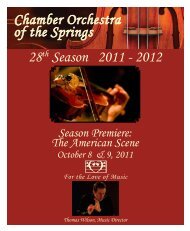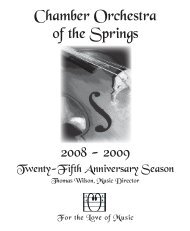Click Here For Concert Program - Chamber Orchestra of the Springs
Click Here For Concert Program - Chamber Orchestra of the Springs
Click Here For Concert Program - Chamber Orchestra of the Springs
You also want an ePaper? Increase the reach of your titles
YUMPU automatically turns print PDFs into web optimized ePapers that Google loves.
upon us fully equipped, as Minerva sprang from <strong>the</strong><br />
brain <strong>of</strong> Jupiter. And he has come, this chosen youth,<br />
over whose cradle <strong>the</strong> Graces and Heroes seem to<br />
have kept watch. His name is Johannes Brahms.”—<br />
Schumann, in <strong>the</strong> Neue Zeitschrift für Musik,<br />
Oct. 28, 1853.<br />
Brahms’ Variations on a Theme by Haydn,<br />
op. 56a, have a curious history. We now know that<br />
Haydn had nothing to do with <strong>the</strong>se magnificent<br />
variations. Though Brahms did not know that,<br />
this achievement <strong>of</strong> turning an obscure tune into<br />
one <strong>of</strong> <strong>the</strong> most beloved <strong>the</strong>mes in music is surely<br />
more significant than its pedigree. Brahms’ friend,<br />
Carl Ferdinand Pohl, <strong>the</strong> author <strong>of</strong> an important<br />
early biography <strong>of</strong> Haydn, first showed Brahms <strong>the</strong><br />
<strong>the</strong>me he would later make famous. Brahms had<br />
always been exceptionally interested in older music;<br />
he closely studied <strong>the</strong> six recently discovered wind<br />
serenades Pohl attributed to Haydn. The second<br />
movement <strong>of</strong> one, in B-flat Major, particularly<br />
attracted him. He wrote it out and put it in a<br />
folder labeled “copies <strong>of</strong> outstanding masterpieces<br />
<strong>of</strong> <strong>the</strong> 16th-18th centuries for study purposes” that<br />
he had been compiling for years. Brahms wrote<br />
<strong>the</strong> words “Chorale St. Antoni” next to <strong>the</strong> <strong>the</strong>me.<br />
In May <strong>of</strong> 1873, Brahms started to compose a set<br />
<strong>of</strong> variations for two pianos on <strong>the</strong> St. Antoni<br />
<strong>the</strong>me. On August 20, he and Clara Schumann<br />
played through <strong>the</strong> work toge<strong>the</strong>r. Sometime<br />
that Summer, Brahms also began an orchestral<br />
version <strong>of</strong> <strong>the</strong> variations, which was premiered<br />
on October 4 by <strong>the</strong> Vienna Philharmonic, and<br />
was rapturously received. The eight variations<br />
were so imaginative and well-crafted, <strong>the</strong>y were<br />
immediately recognized as something unique and<br />
original. Brahms follows with a fur<strong>the</strong>r innovation<br />
in <strong>the</strong> finale, fashioning a five-measure bass line<br />
that he repeats, unchanged, seventeen times—<strong>the</strong><br />
strictness <strong>of</strong> that formula inspiring him to new<br />
heights <strong>of</strong> invention. The work ends in triumph<br />
<strong>Program</strong> Notes, continued<br />
19<br />
with <strong>the</strong> full restatement <strong>of</strong> <strong>the</strong> <strong>the</strong>me. And where<br />
did that <strong>the</strong>me come from? It is now believed that<br />
Brahms’ beloved <strong>the</strong>me is <strong>the</strong> work <strong>of</strong> Haydn’s star<br />
pupil, Ignaz Pleyel. As for Brahms’ “St. Antoni<br />
Chorale” subtitle, that may be his alone!<br />
About Johannes Brahms: Johannes Brahms was<br />
born in Hamburg, Germany, on May 7, 1833.<br />
He first studied music with his fa<strong>the</strong>r, a doublebass<br />
player for <strong>the</strong> Hamburg opera; subsequently<br />
he studied composition with Eduard Marxsen.<br />
Brahms was a talented pianist, giving his first<br />
public recital at <strong>the</strong> age <strong>of</strong> 14.<br />
On a concert tour in 1853 as accompanist<br />
for <strong>the</strong> Hungarian violinist Eduard Remenyi,<br />
Brahms met Franz Liszt, who praised <strong>the</strong> 20-yearold’s<br />
Scherzo in E-Flat Minor and his piano sonatas.<br />
Brahms, however, never became personally friendly<br />
with Liszt, and in 1860 he signed a manifesto<br />
attacking <strong>the</strong> so-called Music <strong>of</strong> <strong>the</strong> Future, which<br />
Liszt championed. More fruitful for Brahms was<br />
his meeting with Robert Schumann, who hailed<br />
<strong>the</strong> young composer as <strong>the</strong> coming genius <strong>of</strong><br />
German music and arranged for <strong>the</strong> publication <strong>of</strong><br />
his first songs and piano sonatas. Schumann died<br />
in 1856, and Brahms remained a devoted friend<br />
<strong>of</strong> his widow, Clara Wieck Schumann, until her<br />
death in 1896. Brahms never married, although<br />
he had a large circle <strong>of</strong> friends and patrons.<br />
After Brahms was rejected for a post as<br />
conductor in Hamburg in 1862, he visited Vienna<br />
and later (1868) made his home <strong>the</strong>re, originally<br />
working as a choral conductor. Brahms conducted<br />
<strong>the</strong> orchestra <strong>of</strong> <strong>the</strong> Society <strong>of</strong> <strong>the</strong> Friends <strong>of</strong><br />
Music in Vienna from 1872 to 1875, after which<br />
he devoted himself entirely to composition.<br />
Brahms made his will in 1891 and <strong>the</strong>n embarked<br />
with renewed vigor on <strong>the</strong> composition <strong>of</strong> many<br />
<strong>of</strong> his best works. These later works were mostly<br />
unpublished until after Brahms died in Vienna on<br />
April 3, 1897.




